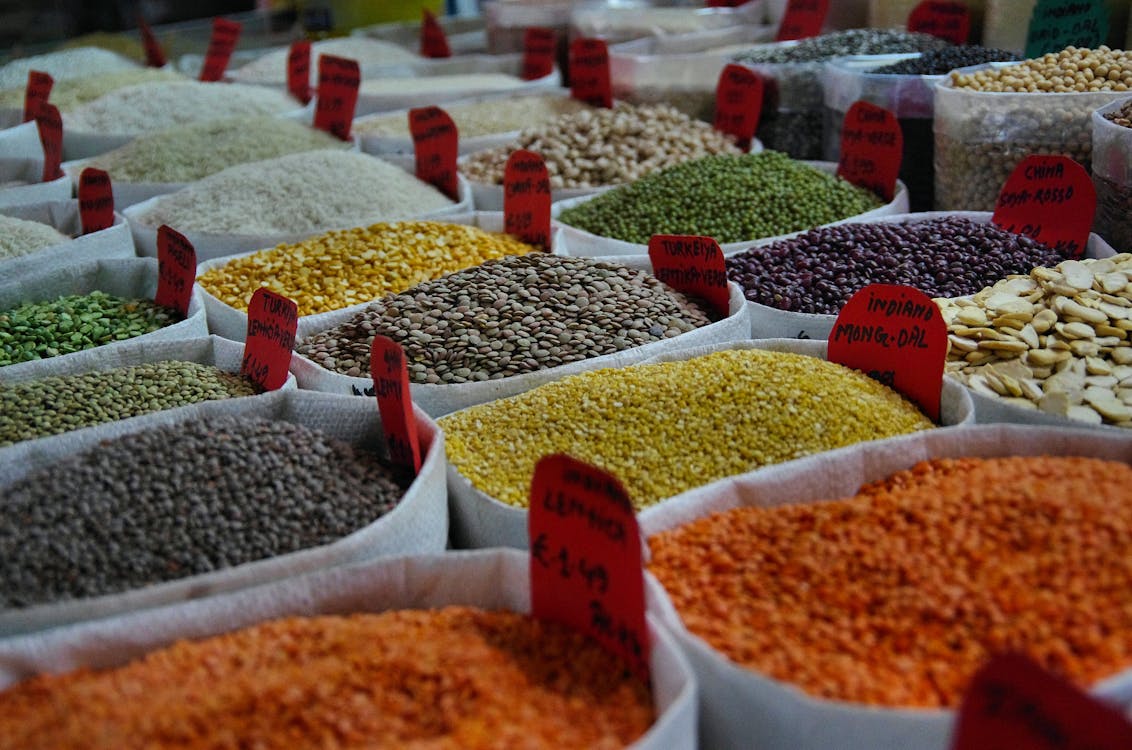
Eating nutrient-dense foods is crucial for maintaining good health, but it can be challenging to do so on a budget. However, with some smart shopping strategies, it is possible to make healthy food choices without breaking the bank. Here are some tips for shopping for nutrient-dense foods on a budget.
1- Shop In-season Nutrient-dense Foods:
Shopping for in-season nutrient-dense foods is not only a wise choice for your wallet but also for your overall health and taste buds. The concept of eating in-season has been practiced for centuries, and for good reason.
When fruits and vegetables are in season, they are typically more abundant, which leads to a decrease in their prices. You can often find great deals and discounts on in-season produce at local farmers’ markets or grocery stores. These cost savings can add up over time, making it easier to maintain a nutritious diet without breaking the bank.
Besides being kinder to your budget, in-season produce boasts higher nutritional value. Fruits and vegetables reach their peak nutrient content when they are allowed to ripen naturally in their own season. They are picked at the optimal time, ensuring they are packed with vitamins, minerals, and antioxidants. On the other hand, out-of-season produce might be harvested prematurely and then transported long distances, causing it to lose some of its nutritional potency along the way.
Not only is in-season produce nutritionally superior, but it also tastes better. There’s nothing quite like the flavor of a freshly picked, ripe, and juicy piece of fruit or a crisp and vibrant vegetable. When you buy in-season, you get to experience the full natural taste that these foods have to offer, making them more enjoyable to eat.
Furthermore, supporting local farmers and businesses by purchasing in-season produce can have positive effects on the community and the environment. When you buy from local farmers’ markets, you’re reducing the carbon footprint associated with long-distance transportation. This decision contributes to a more sustainable food system and helps maintain a healthy ecosystem.
To take full advantage of in-season produce, it’s essential to know what’s available each season. Different regions may have slightly different growing seasons due to climate variations, so it’s worth checking with local farmers’ market vendors or doing some research online to find the best times to purchase specific fruits and vegetables in your area.

Eating in-season does not mean you have to compromise variety or flavor in your diet. Each season offers a diverse range of produce, from vibrant summer berries to hearty fall squashes and winter citrus fruits. Embracing the variety of each season’s offerings can also encourage culinary creativity, as you explore new recipes and dishes that showcase the unique flavors of the time.
2- Buy frozen or canned produce:
When it comes to maintaining a healthy and balanced diet, fresh produce often takes center stage. However, don’t underestimate the nutritional value and convenience that frozen and canned produce can bring to your meals. Incorporating these options into your shopping routine can be a smart move for both your health and your wallet.
Frozen fruits and vegetables, in particular, are an excellent alternative to fresh produce, especially when certain items are out of season or unavailable locally. The freezing process locks in the nutrients of the fruits and vegetables, preserving their vitamins and minerals. As a result, you can enjoy the goodness of these nutrient-dense foods even when they are not in season. Another advantage of frozen produce is that they are usually pre-washed and pre-cut, saving you time and effort in the kitchen.
Canned produce also has its merits, providing a shelf-stable option that can last for an extended period. The canning process involves sealing the food in an airtight container, which helps to maintain its nutritional value. However, it is crucial to be mindful of the added ingredients that some canned products may contain. When purchasing canned nutrient-dense foods, always read the labels and opt for options with no added sugars or salt. Choosing products that are packed in their natural juices or water rather than heavy syrups is also a healthier choice.
While canned vegetables can be a convenient pantry staple, they often contain some sodium to enhance preservation. To reduce the sodium content, you can rinse the canned vegetables under running water before using them in your recipes. This simple step helps to wash away excess salt, making your meals healthier.
One significant advantage of buying frozen or canned produce is their longer shelf life. Fresh fruits and vegetables can spoil relatively quickly, leading to food waste and increased grocery expenses. By having frozen or canned options on hand, you can avoid waste and always have nutritious ingredients available for your meals.
In addition to their nutritional benefits, frozen and canned produce can be more budget-friendly compared to fresh options, especially when certain items are not in season. Buying in bulk or during sales can lead to additional cost savings, allowing you to stretch your food budget further while still maintaining a balanced diet.
It’s essential to remember that a well-rounded diet can include a combination of fresh, frozen, and canned nutrient-dense foods. The key is to strike a balance that works for you and your lifestyle. Fresh produce might be the preferred choice when it’s in season and readily available, but frozen and canned options can be a reliable backup plan to ensure you always have access to the essential vitamins, minerals, and fiber that fruits and vegetables provide.

As with any food purchase, it’s essential to read labels and make informed choices. Look for reputable brands that prioritize quality and avoid products with added sugars, salt, or preservatives. By being a conscious consumer, you can make the most of frozen and canned produce while still nourishing your body with the nutrients it needs to thrive.
3- Purchase whole grains:
When it comes to building a well-rounded and nutritious diet, whole grains play a crucial role in providing essential nutrients and fiber that promote overall health and well-being. Unlike their refined counterparts, whole grains retain all parts of the grain kernel, including the bran, germ, and endosperm. This unique composition ensures that they are packed with a wide array of vitamins, minerals, and dietary fiber.
Brown rice, for example, is a popular whole grain known for its nutty flavor and versatility. It is an excellent source of complex carbohydrates, which provide a steady release of energy throughout the day, helping to maintain stable blood sugar levels. Additionally, brown rice is rich in essential minerals like magnesium and selenium, which play vital roles in supporting various bodily functions, including muscle function and immune system health.
Quinoa is another nutrient-dense whole grain that has gained immense popularity in recent years. Unlike many other grains, quinoa is a complete protein, meaning it contains all nine essential amino acids required by the human body. This makes it an excellent option for vegetarians and vegans looking to meet their protein needs without relying solely on animal products. Quinoa is also rich in iron, folate, and fiber, making it a nutritional powerhouse that supports healthy red blood cells and digestive function.
Whole-wheat pasta is a delicious alternative to regular pasta made from refined wheat flour. It provides a more substantial dose of fiber and nutrients, such as B vitamins and minerals like zinc and manganese. The higher fiber content in whole-wheat pasta aids in digestion and helps you feel fuller for longer, making it a valuable addition to a balanced diet.
In addition to their nutritional benefits, whole grains are often more cost-effective than their processed counterparts. While processed grains like white rice and pasta may seem cheaper at first glance, they lack the valuable nutrients and fiber that whole grains offer. As a result, you may find yourself needing to consume larger portions of processed grains to feel satisfied, leading to increased overall food costs.
When shopping for whole grains, consider buying in bulk at your local grocery store or food co-op. Bulk options often provide better value for money, and you can purchase the exact quantity you need, reducing the risk of food waste. Many stores also offer a diverse selection of whole grains in bulk, allowing you to experiment with different varieties and flavors.
Moreover, incorporating whole grains into your diet doesn’t have to be complicated. You can easily swap out refined grains for whole grains in your favorite recipes. For example, try using brown rice instead of white rice in stir-fries or quinoa in place of couscous in salads. These simple changes can elevate the nutritional profile of your meals and contribute to your overall well-being.

As with any dietary change, it’s essential to listen to your body and find what works best for you. Some individuals may have sensitivities or allergies to certain grains, so it’s essential to consult with a healthcare professional if you have any concerns.
4- Choose a plant-based protein:
Opting for plant-based protein sources can be a budget-friendly and nutritious choice, especially for those seeking a more affordable alternative to animal protein. Not only do plant-based proteins offer a plethora of health benefits, but they also contribute to environmental sustainability and animal welfare.
Beans, lentils, and tofu are fantastic examples of nutrient-dense plant-based proteins that can be easily incorporated into a variety of dishes. Beans, such as black beans, kidney beans, chickpeas, and pinto beans, are not only rich in protein but also high in fiber, iron, and various vitamins and minerals. This nutritional profile makes them a filling and heart-healthy choice that helps stabilize blood sugar levels and supports digestive health.
Lentils, on the other hand, are a powerhouse of protein and fiber. They come in various colors, including green, brown, red, and black, each with its unique flavor and texture. Lentils are not only an excellent source of plant-based protein but also contain folate, magnesium, and potassium, all of which play vital roles in maintaining overall health and wellness.
Tofu, made from soybeans, is an incredibly versatile plant-based protein that can take on various flavors and textures based on how it’s prepared. It is a complete protein, providing all nine essential amino acids necessary for the body’s functions. Additionally, tofu is a good source of calcium, iron, and other essential minerals, making it a valuable addition to a balanced diet, especially for vegetarians and vegans.
One of the great advantages of plant-based proteins like beans, lentils, and tofu is their affordability. These protein sources are generally more cost-effective than animal proteins, making them an excellent choice for those on a budget or looking to reduce their grocery expenses. Canned or dried beans, in particular, are often more budget-friendly than fresh beans, and buying them in bulk can provide additional savings.
Canned beans offer the convenience of being pre-cooked, saving you time and effort in the kitchen. They are also shelf-stable, allowing you to stock up and have a readily available protein source whenever needed. Dried beans, while requiring soaking and cooking, are even more economical and can be stored for extended periods, making them a valuable pantry staple.
Incorporating plant-based proteins into your meals not only benefits your health and budget but also contributes to a more sustainable and ethical food system. Plant-based protein sources have a significantly lower environmental impact compared to animal proteins, as they require fewer natural resources and produce fewer greenhouse gas emissions. By choosing plant-based options, you can play a part in reducing your ecological footprint and promoting a greener and more sustainable future.

When preparing meals with plant-based proteins, get creative with your recipes. Experiment with different spices, herbs, and flavor combinations to enhance the taste and texture of your dishes. For example, you can marinate tofu before cooking it or mix various beans and lentils to create hearty and flavorful stews or salads.
5- Buy Nutrient-dense Foods in bulk:
Purchasing nutrient-dense foods in bulk is a savvy and cost-effective approach that not only benefits your wallet but also supports your journey towards a healthier lifestyle. Whether you’re a health-conscious individual or simply looking to optimize your grocery budget, buying in bulk can be a game-changer.
One of the most significant advantages of buying nutrient-dense foods in bulk is the potential for substantial savings. Bulk items are often priced lower per unit compared to their individually packaged counterparts. This means that by purchasing in larger quantities, you can enjoy significant discounts, ultimately reducing your overall grocery expenses. Over time, these savings can add up, giving you more financial freedom to invest in other aspects of your well-being.
When it comes to nutrient-dense foods, there is a wide variety of options available for bulk purchase. Grains like brown rice, quinoa, oats, and whole-wheat pasta are staples that can be bought in bulk and stored for extended periods without losing their nutritional value. These complex carbohydrates provide sustained energy and are essential for a balanced diet.
Beans and legumes, such as black beans, lentils, chickpeas, and kidney beans, are excellent sources of plant-based protein and fiber. Buying them in bulk allows you to incorporate these protein powerhouses into a variety of dishes, from hearty stews and salads to flavorful curries and dips.
Nuts and seeds are another category of nutrient-dense foods that can be easily purchased in bulk. Options like almonds, walnuts, chia seeds, and flaxseeds are rich in healthy fats, protein, and essential minerals. Adding a sprinkle of nuts and seeds to your breakfast smoothie or yogurt, or using them as a topping for salads, can elevate both the taste and nutritional profile of your meals.
Many local grocery stores and food co-ops offer bulk sections, where you can find a diverse array of nutrient-dense foods packaged in eco-friendly containers. Buying in bulk is not only good for your budget but also reduces single-use plastic waste, contributing to a more sustainable and environmentally friendly shopping practice.
To make the most of your bulk purchases, it’s essential to plan and store your items properly. Investing in air-tight containers or reusable storage bags can help keep your nutrient-dense foods fresh and extend their shelf life. Additionally, organizing your pantry with clearly labeled containers makes it easy to access and utilize the ingredients in your various recipes.
Before purchasing in bulk, consider the storage space available in your home. Buying larger quantities is advantageous, but you’ll want to ensure that you have enough room to store the items properly. A well-organized pantry or storage area will not only help you keep track of your stock but also make meal preparation more efficient.

While buying nutrient-dense foods in bulk is generally a wise choice, it’s essential to be mindful of expiration dates. Since you may not consume the entire bulk quantity right away, keep an eye on the freshness of your items and rotate your stock regularly to use older items first.
6- Plan meals ahead of time:
Meal planning is a powerful tool that not only contributes to financial savings but also streamlines your daily routine, promotes healthier eating habits, and reduces your environmental impact. By taking a little time each week to plan your meals ahead, you can enjoy numerous benefits that positively impact both your budget and overall well-being.
One of the most significant advantages of meal planning is its ability to help you save money. When you plan your meals in advance, you can create a well-structured shopping list based on exactly what you need for the week. This targeted approach minimizes impulse purchases and reduces the likelihood of buying unnecessary items, ultimately leading to lower grocery bills. Additionally, knowing exactly what you’re going to cook and eat for the week allows you to buy ingredients in bulk or take advantage of sales and discounts, further stretching your budget.
Another crucial aspect of meal planning is its role in reducing food waste. When you plan your meals, you’re more likely to use up all the ingredients you purchase since you have a specific purpose for each item. This prevents ingredients from languishing at the back of your fridge and eventually being thrown away. Food waste not only squanders your money but also contributes to environmental issues, such as greenhouse gas emissions from rotting food in landfills. By reducing food waste through meal planning, you can take a positive step towards sustainability.
Using weekly sales flyers to plan your meals is a smart strategy to save money. Take some time to review the sales and promotions offered by your local grocery stores, and plan your meals around the discounted items. Building your menu based on sales allows you to take advantage of the best deals available, helping you cut costs without compromising on the quality and variety of your meals.
Moreover, meal planning fosters healthier eating habits. When you plan your meals in advance, you have the opportunity to create well-balanced and nutritious menus. By incorporating a variety of nutrient-dense foods like fruits, vegetables, whole grains, and lean proteins, you can ensure that your diet is rich in essential vitamins and minerals. Planning your meals also allows you to control portion sizes, which can be beneficial for weight management and overall health.
The convenience aspect of meal planning should not be overlooked. Knowing what you’ll be cooking each day removes the stress of deciding what to eat last minute. It can also save you time in the kitchen, as you can prepare certain components of your meals in advance or cook in larger batches to have leftovers for later in the week. With a well-thought-out meal plan, you’ll have more time for other activities and enjoy a more relaxed dining experience.
To get started with meal planning, set aside some time each week to create your menu. Consider your schedule, preferences, and dietary needs when selecting recipes. Don’t be afraid to repeat favorite meals or create theme nights, such as “Taco Tuesday” or “Meatless Monday,” to add variety and excitement to your weekly meal plan.

Additionally, involve your family or household members in the meal planning process. Taking their preferences and input into account will increase their excitement about the meals and ensure that everyone is on board with the plan.
7- Avoid processed foods:
Making a conscious effort to avoid processed foods and instead choosing whole, unprocessed foods can significantly impact your health, well-being, and financial stability. Processed foods, which typically undergo extensive manufacturing and contain added ingredients, often come with a higher price tag compared to whole foods. Furthermore, they tend to be less nutrient-dense, making them less beneficial for your overall nutrition.
One of the key reasons processed foods can be more expensive is the additional costs involved in their production and packaging. The manufacturing processes used to create processed foods require various steps, machinery, and labor, all of which contribute to the final cost of the product. Additionally, the packaging and marketing of processed foods further add to their price. In contrast, whole foods, such as fruits, vegetables, grains, and legumes, have minimal processing and packaging, making them more affordable options.
While processed foods might seem more convenient due to their pre-packaged and ready-to-eat nature, they often lack essential nutrients found in whole foods. Processing can strip foods of their natural vitamins, minerals, and fiber, leading to a decrease in their nutritional value. Many processed foods are also high in unhealthy fats, added sugars, sodium, and artificial additives, which can negatively impact your health when consumed regularly.
On the other hand, whole foods are rich in nutrients and offer a wide array of health benefits. Fruits and vegetables are packed with vitamins, minerals, and antioxidants that support immune function, promote healthy skin, and protect against chronic diseases. Whole grains provide a steady release of energy, dietary fiber for digestive health, and an abundance of essential nutrients like B vitamins and iron. Legumes, such as beans and lentils, are excellent sources of plant-based protein, fiber, and various minerals that contribute to heart health and weight management.
By prioritizing whole, unprocessed foods, you’re making a proactive choice to nourish your body with the best possible nutrients while avoiding the negative effects associated with processed foods. Not only will you feel more energized and vibrant, but you may also experience better digestion, improved immunity, and enhanced overall well-being.
To stick to whole foods as much as possible, consider planning your meals around fresh, seasonal produce and whole grains. Visiting local farmers’ markets can be an excellent way to find affordable and high-quality whole foods while supporting local producers. Additionally, bulk buying whole foods like rice, oats, nuts, and seeds can be a cost-effective way to ensure a well-stocked pantry.
It’s essential to read food labels and be mindful of hidden additives when purchasing packaged items. Look for products with minimal ingredients and avoid those with long lists of artificial additives and preservatives. Cooking from scratch at home also allows you to control the ingredients used, giving you complete transparency over what goes into your meals.
While it may take some time and effort to transition away from processed foods, the long-term benefits are well worth it. Not only will you save money on your grocery bills, but you’ll also invest in your health and make a positive impact on your overall lifestyle. Embracing whole, unprocessed foods as the foundation of your diet will set you on a path towards improved nutrition, well-being, and financial sustainability.

By following these tips, you can shop for nutrient-dense foods on a budget. Remember, eating healthy doesn’t have to be expensive, and small changes can make a big difference in your overall health and well-being.
Nutrient-Dense Foods: Nourishing the Body and Mind:
Nutrient-dense foods are the nutritional powerhouses that fuel our bodies with a wealth of essential vitamins, minerals, and other nutrients, without packing unnecessary calories. These foods offer a high concentration of nutrients per calorie, making them a crucial component of a balanced and healthful diet. Embracing nutrient-dense foods is a proactive step towards nourishing our bodies and minds, promoting overall well-being and vitality.
Fruits and vegetables are prime examples of nutrient-dense foods, boasting an array of vitamins, minerals, fiber, and antioxidants. From vibrant berries packed with immune-boosting vitamin C to leafy greens abundant in bone-strengthening calcium, these plant-based foods provide an assortment of health benefits. Incorporating a rainbow of fruits and vegetables into daily meals ensures a diverse range of nutrients that support various bodily functions and help protect against chronic diseases.
Whole grains, another cornerstone of nutrient-dense foods, offer a rich source of complex carbohydrates, fiber, and essential nutrients. Foods like quinoa, brown rice, and whole wheat provide sustained energy and promote digestive health, contributing to improved blood sugar control and satiety. Their wealth of vitamins, minerals, and antioxidants also aids in reducing the risk of heart disease and supporting overall wellness.

Lean proteins, such as fish, poultry, beans, and legumes, are essential components of a nutrient-dense diet. These foods are rich in complete proteins, iron, zinc, and B vitamins, supporting muscle growth, immune function, and cell repair. Incorporating lean proteins into meals promotes satiety and helps maintain stable blood sugar levels, making them valuable for weight management and overall metabolic health.
Healthy fats found in foods like avocados, nuts, and olive oil are an integral part of a nutrient-dense diet. These fats are a rich source of monounsaturated and polyunsaturated fats, which are beneficial for heart health and cognitive function. Moreover, they aid in the absorption of fat-soluble vitamins like A, D, E, and K, enhancing the overall nutritional value of meals.



